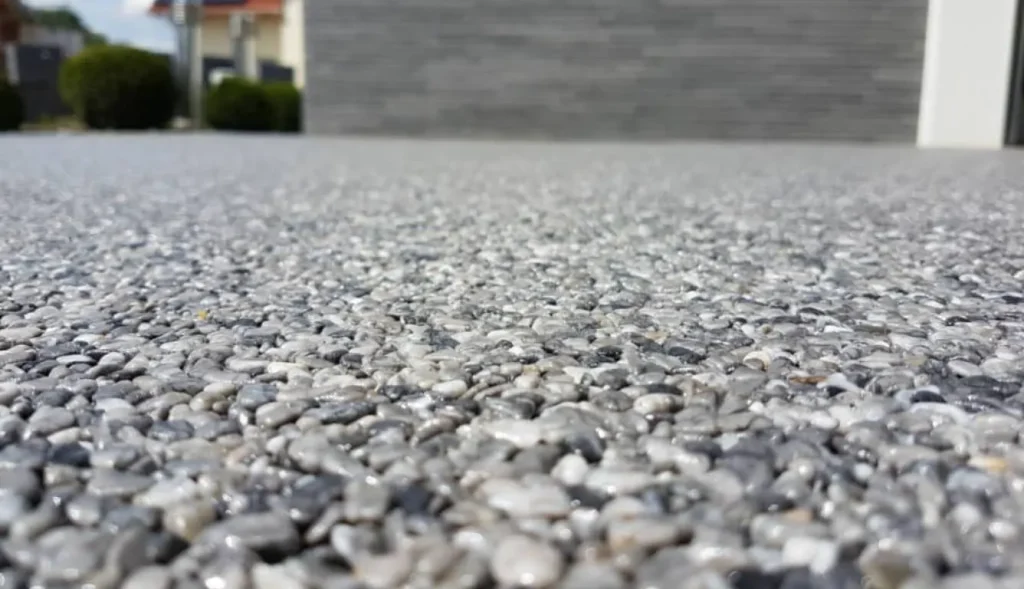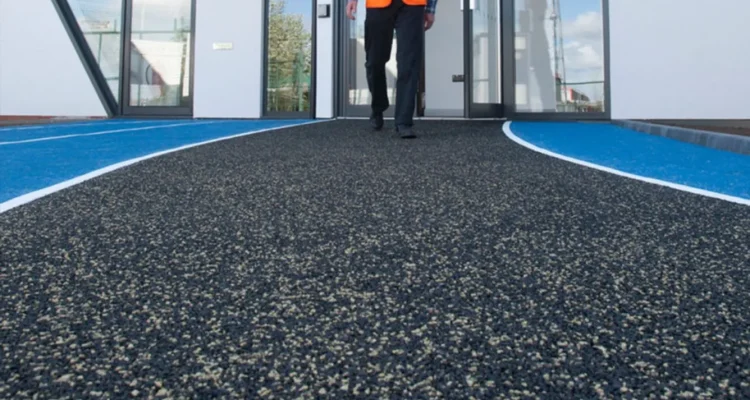What Is Stone Carpet?
Stone carpet, also referred to as resin-bound gravel, is a flooring solution that uses a blend of natural stone aggregates bound together with a resin binder. The result is a durable, visually appealing surface that mimics the appearance of a traditional gravel path but with enhanced performance and longevity. This type of flooring is becoming increasingly popular in both residential and commercial settings due to its aesthetic versatility and practical benefits.

History and Evolution
The concept of stone carpet has evolved from traditional gravel pathways and driveways. With advancements in resin technology, stone carpet has become a sophisticated and refined option for modern flooring needs. The process has been refined to enhance its durability and appearance, making it a preferred choice for contemporary interiors and exteriors.
Components of Stone Carpet
Understanding the components of stone carpet helps in appreciating its functionality and aesthetic appeal. The main components are natural stone aggregates, resin binder, and base layers.
Natural Stone Aggregates
The core of stone carpet is the natural stone aggregates, which can vary from pebbles and gravel to crushed granite or marble. These stones provide the texture and visual interest of the flooring.
Resin Binder
The resin binder is a crucial element that holds the stones together. It creates a strong, flexible bond that ensures the stones remain securely in place while providing a smooth, seamless surface.
Base Layers
Proper installation requires a stable base layer, typically made of asphalt or concrete. This layer ensures that the stone carpet adheres properly and remains level over time.
Benefits of Stone Carpet
Stone carpet offers numerous advantages over traditional flooring options. Let’s delve into some of the most compelling benefits.
Aesthetic Appeal
One of the standout features of stone carpet is its aesthetic versatility. Available in a variety of colors and textures, it can be customized to suit any design preference. Whether you’re looking for a classic gravel look or a more polished finish, stone carpet can meet your needs.
Durability and Longevity
Stone carpet is known for its durability. The combination of natural stones and resin creates a robust surface that can withstand heavy foot traffic, weather conditions, and general wear and tear. This makes it an excellent choice for both residential and commercial applications.
Low Maintenance
Maintaining a stone carpet is relatively simple compared to other flooring options. Routine sweeping and occasional washing are usually sufficient to keep it looking its best. The resin binder also helps to prevent weeds and moss from growing between the stones.
Safety Features
Stone carpet provides a non-slip surface, which is especially beneficial in wet conditions. The textured surface reduces the risk of slipping, making it a safer option for areas prone to moisture.
Types of Stone Carpet
Stone carpet comes in various types, each with unique characteristics and applications. Here’s a closer look at the different types available.
Standard Stone Carpet
Standard stone carpet features a basic mix of natural stone aggregates and resin. It’s a cost-effective option suitable for most general applications.
Polished Stone Carpet
For a more refined look, polished stone carpet offers a smoother, glossy finish. This type is often used in high-end residential and commercial settings where aesthetics are a priority.
Decorative Stone Carpet
Decorative stone carpet incorporates various colors, shapes, and sizes of stones to create intricate patterns and designs. This option allows for greater customization and artistic expression.
Applications of Stone Carpet
Stone carpet is highly versatile and can be used in various settings. Here are some common applications.
Residential Use
In residential settings, stone carpet is often used for driveways, walkways, patios, and flooring inside homes. Its durability and aesthetic appeal make it a popular choice for enhancing curb appeal and interior design.
Commercial Use
Commercial properties benefit from stone carpet’s durability and low maintenance requirements. It’s commonly used in office buildings, shopping centers, and public spaces where heavy foot traffic is expected.
Outdoor and Indoor Applications
Stone carpet can be used both outdoors and indoors. Its ability to handle different weather conditions makes it suitable for external applications, while its clean, modern look fits well in indoor spaces.
Installation Process
Proper installation is key to ensuring the longevity and performance of your stone carpet. Here’s a step-by-step guide to the installation process.
Preparation and Surface Cleaning
Before installing stone carpet, the surface must be thoroughly cleaned and prepared. Any debris, oil, or existing coatings should be removed to ensure proper adhesion.
Mixing and Application
The stone aggregates are mixed with the resin binder according to specific ratios. This mixture is then applied to the prepared surface, ensuring an even distribution of stones.
Curing and Finishing
Once applied, the stone carpet needs time to cure. This curing period allows the resin to fully set and bond with the stones. After curing, the surface is inspected and any necessary finishing touches are made.
Cost Considerations
The cost of stone carpet can vary based on several factors, including the type of stone, resin quality, and the size of the area to be covered.
Factors Affecting Cost
Some of the main factors influencing the cost include the complexity of the design, the type of stone used, and the labor involved in installation.
Comparing with Other Flooring Options
When compared to traditional flooring options like tile or concrete, stone carpet can be more affordable, especially considering its durability and low maintenance needs.
Maintenance Tips
Maintaining your stone carpet is straightforward but important for preserving its appearance and functionality.
Routine Cleaning
Regular sweeping and occasional washing with a mild detergent are usually sufficient to keep your stone carpet clean.
Dealing with Stains
For stubborn stains, a specialized cleaner may be required. It’s important to address stains promptly to prevent them from setting.
Long-Term Care
Regular inspections and minor repairs can help extend the life of your stone carpet. Addressing any issues early can prevent more significant problems down the line.
Common Problems and Solutions
While stone carpet is a robust flooring option, some issues may arise. Here’s how to address common problems.
Cracking and Wear
Cracking can occur due to underlying surface issues or heavy impact. Ensuring proper installation and addressing any surface issues can help prevent cracks.
Resin Discoloration
Discoloration of the resin can happen over time due to UV exposure. Using UV-resistant resin can help mitigate this issue.
Uneven Surface
An uneven surface can result from improper installation or base layer issues. Regular inspections and proper installation techniques can help ensure a level surface.
DIY vs. Professional Installation
Deciding between DIY and professional installation depends on your skill level and the complexity of the project.
Pros and Cons of DIY Installation
DIY installation can save money but may require significant time and effort. It’s essential to follow proper procedures and use high-quality materials.
Benefits of Hiring a Professional
Professional installers have the experience and tools necessary to ensure a high-quality result. They can handle complex designs and provide warranties for their work.
Choosing the Right Stone Carpet
Selecting the right stone carpet involves considering several factors.
Factors to Consider
Consider the intended use, desired appearance, and budget when choosing your stone carpet. It’s also helpful to view samples and consult with experts.
Popular Stone Types and Colors
Popular options include granite, marble, and river pebbles. The choice of color and type will depend on your aesthetic preferences and the setting.
Environmental Impact
Stone carpet is generally considered an environmentally friendly option.
Sustainability of Materials
Natural stone is a renewable resource, and the resin used can often be sourced from sustainable practices.
Energy Efficiency
Stone carpet can contribute to energy efficiency by providing good insulation properties, reducing heating and cooling costs.
Stone Carpet vs. Other Flooring Options
Comparing stone carpet to other flooring options can help you make an informed decision.
Stone Carpet vs. Traditional Carpeting
Unlike traditional carpeting, stone carpet is more durable, easier to clean, and offers a unique look.
Stone Carpet vs. Tile Flooring
Stone carpet provides a seamless surface and better slip resistance compared to tile flooring.
Stone Carpet vs. Concrete Flooring
Stone carpet offers a more attractive finish and is generally more comfortable underfoot than concrete flooring.
Future Trends in Stone Carpet
The future of stone carpet looks promising with ongoing innovations and market trends.
Innovations and Advances
Advancements in resin technology and new stone types are expanding the possibilities for stone carpet applications.
Market Trends
The growing popularity of eco-friendly and customizable flooring options is likely to drive further interest in stone carpet.
FAQs
- Is stone carpet suitable for high-traffic areas?
- Yes, stone carpet is durable and can withstand high-traffic areas, making it suitable for both residential and commercial use.
- Can stone carpet be installed over existing flooring?
- It is generally recommended to install stone carpet over a prepared and clean base surface. Installing over existing flooring may require additional preparation.
- How long does it take for stone carpet to cure?
- The curing time for stone carpet typically ranges from 24 to 48 hours, depending on the resin and environmental conditions.
- Can I install stone carpet myself?
- While DIY installation is possible, professional installation is recommended for complex designs and to ensure a high-quality finish.
- How do I remove stains from stone carpet?
- For most stains, regular cleaning with a mild detergent is effective. For persistent stains, a specialized cleaner may be required.
Conclusion
Stone carpet is a versatile, durable, and aesthetically pleasing flooring option suitable for a range of applications. Its combination of natural stone and resin technology offers a unique alternative to traditional flooring options. Whether you’re considering it for a residential or commercial space, understanding its benefits, installation process, and maintenance requirements will help you make an informed decision.


Congratulation!